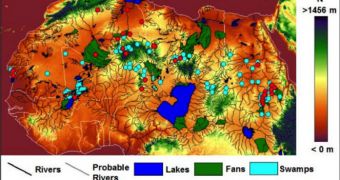The most recent discoveries made in one of the most famous deserts in the world show that fish swam there in ancient times. The finding may hold additional pieces in the puzzle that seeks to explain how and why early humans emigrated out of Africa during the great migrations.
One of the most important questions that researchers have always posed related to the human exodus refers to how our ancestors were able to cross the vast expanses of the desert.
The Cradle of Life – the area where our modern ancestors are thought to have originated in – is located around the area of Ethiopia, therefore south of the Sahara. Since it's highly unlikely that people left the continent on boats headed for India, experts wonder how they managed to pass the sand barrier.
When all is said and done, the fact remains that Sahara is the largest hot desert in the world, where scorching temperatures fry travelers by daytime, and where the cold freezes them during the night.
A quick look at any physical map of Africa will reveal that the Sahara is covering the entire width of the continent, from coast to coast, like a genuine barrier. The only possible route of escape would have been through the Nile River Valley, experts proposed many years ago.
But there have been little tangible evidence to support these claims. Estimates of how much water the valley contained in the distant past are still unavailable, and so the debate over this issue is ongoing.
What the new discoveries show is that the desert may have not in fact been as difficult to pass as initially believed. “Fish appeared to have swam across the Sahara during its last wet phase sometime between 10,000 and 6,000 years ago,” scientist Nick Drake says.
“The Sahara is not a barrier to the migrations of animals and people. Thus it is possible – likely? – that early modern humans did so, and this could explain how we got out of Africa,” adds the King's College London geographer, quoted by LiveScience.
The new findings are in tune with the results of previous investigations, which revealed signs that rivers, lakes and inland deltas once existed in what is now the scorching desert.
Further demonstrating the idea that people leaving Africa did not take the Nile route is the fact that Sahara was actually green some 125,000 years ago, when the earliest, anatomically-modern humans are believed to have started their migration.
But Drake says that continuing the work might simply prove too dangerous. Some of the nations that need to be visited in order to get the full picture of how the desert looked like are in disarray, or plagues by conflicts, civil war and terrorist groups.
Details of the recent study were published in the December 27 online issue of the esteemed journal Proceedings of the National Academy of Sciences (PNAS).

 14 DAY TRIAL //
14 DAY TRIAL //